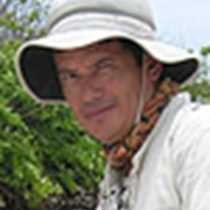Isabela & Fernandina Islands
After a long navigation, we arrived at Isabela, the largest island in the Galápagos archipelago. Early in the morning we awoke to see the beautiful formation of Ecuador volcano, which is crossed by the Equator line. All of our guests participated in the traditional ceremony of crossing the Ecuadorian flag, while we crossed into the southern hemisphere. Afterwards, we started one of the most beautiful Zodiac rides in Galápagos. We encountered a variety of marine animals such as penguins, fur sea lions, blue-footed boobies, flightless cormorants and marine turtles. The turtles came incredibly close to the boats, allowing our guests to take pictures of them together. Suddenly, among the turtles, a penguin appeared very quickly chasing fish. Then the penguin came back, walking on the rocks, stopping and posing for us, as if inviting us to take pictures of him.
We went back to the National Geographic Endeavour and prepared for deep water snorkeling. Seeing the sea turtles from the Zodiac was nothing compared to swimming with them in the water. We counted dozens of them everywhere. On our way back to the ship, we spotted a rare dorsal fin and decided to take a closer look. We discovered the fin belonged to was one of four Mola-mola sun fish swimming unconcernedly beside us.
In the afternoon, we landed at Fernandina Island, the youngest in Galápagos. We disembarked on the small dock without problems, but because of the high tide, water filled a part of our trail and we had to cross the area barefoot or with aqua shoes. When we arrived at the black lava field, we observed a Galápagos hawk standing on one of the mangrove trees, looking for iguanas or some lizards. Our guests began to compare this species with birds in other parts of the world, concluding that it was incredible to see a terrestrial bird surviving on this remote archipelago.
On the black rocks, some very large marine iguanas were spotted resting and preparing to pass a very cold night. They will remain together all night when their only source of heat will be their own body temperature: “Together is better” one of our guests replied.
We crossed the flightless cormorant nesting area and saw many of them drying their short wings on the rocks. Another group was in the water swallowing fish and swimming against the strong currents. Off the beach a huge male sea lion patrolled his beach barking, protecting his harem.
It was incredible! A place that from far away appeared barren was full of life, and additionally many different species of creatures shared it peacefully. Just before a beautiful sunset we came back on board, tired but happy, because today was a beautiful day.
Call +1.800.397.3348 or contact your travel advisor




